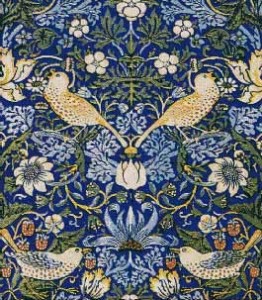Motherboard printing
January 29th, 2012 By Michael NitscheThis idea was inspired by the ornamental work that was part of the William Morris article we read for the week – and how his sense of form and function differs from the cooperate style that is so dominant at Georgia Tech. I am often confused by ornamental art and wonder why anybody would spend his or her time making exactly this pattern. Here is one of Morris’ patterns, for example:
So, in my project I try to get a pattern without really designing it but instead using pure functionality. To do so, the project uses print techniques and computer hardware components as shapes.
The main design task for a motherboard or circuit is functionality. To save space and money, these boards are usually optimized not for any aesthetic value but for cheapest and most reliable operation. What if one could take the trace of this optimization and use it in our crafts context? Then you would get a shape that reflects optimized function but – I argue in this project – is also an ornamental pattern.
To do my craft exercise, you need:
– colors
– brushes
– an old board (I took one from an old remote control car)
– some paper
– some piece of clothing (I used some socks)
You paint the backside of the board with a color of your choice, do some test prints on the paper to get rid of the surplus paint, and when you start to get the desired result with the motherboard shape, you print on the piece of clothing.
I used a remote control car and some socks to play with the idea that you can wear the interiors of a electric car on your feet. Maybe it speeds you up?

January 30th, 2012 at 9:05 am
In doing this project I had to alter the technique in order to get crafted results. The underside of the soldered board did not have enough surface area to transfer paint onto socks in any meaningful pattern, and the solder nubs were not sufficiently raised for the paint on the board to avoid transferring to the fabric. So, in addition to the original circuit board provided, I grabbed a few more out of some cheap electronics items (Sylvania Dot-It lights and light-up luggage tags). I sewed these onto the leg of the socks above the ankles, which prove to be quite colorful and futuristic fashions. Sewing the boards onto the socks was easier than I suspected, since natural perforations abound.